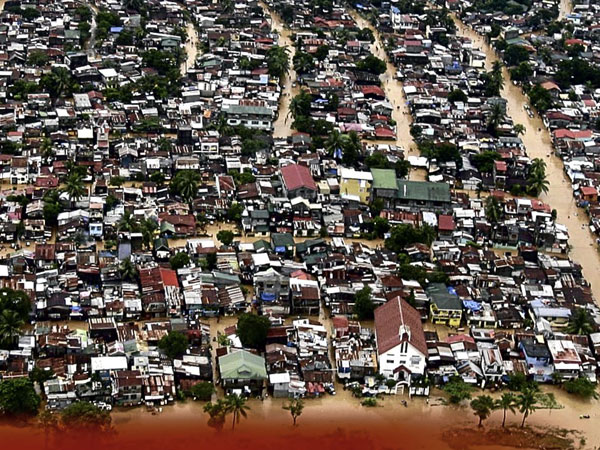Turning disaster prone metro into a safe, sustainable haven
Is Metro Manila still a safe haven for its residents?
When Tropical Storm “Ondoy” wreaked havoc across Metro Manila in 2009, destroying properties and claiming numerous lives, Filipinos had been unified in saying it was time to have in place a more comprehensive urban planning that will ensure the security of its residents.
World-renowned urban planner and architect Felino “Jun” Palafox Jr. even submitted then to former President Gloria Macapagal-Arroyo a total of 83 recommendations, which Palafox said would not only help make Metro Manila less vulnerable to disasters, but could also help propel the Philippines into becoming one of the Top 20 economies in the world by 2025.
Unfortunately, the aggressive thrust then to implement all these 83 recommendations—of which only two, according to Palafox, were implemented—seems to have slowed down as the government needed also to attend to the more pressing issues of poverty, security and so on.
Also, it was a comforting thought then to learn that an Ondoy-like disaster occurs only once in every 100 years.
Article continues after this advertisementYet after only three years, the horrors of Ondoy have again resurfaced when a monsoon left a trail of destruction again in Metro Manila, with its torrential rains and massive flooding early this week—again putting in peril hundreds and thousands of people living in the metropolis. More importantly, this is yet proof that not much has been achieved in terms of urban planning.
Article continues after this advertisementPalafox however believes that it is not too late to turn things around.
In an interview, Palafox said he remains optimistic that Metro Manila will remain livable as long as the government gets “more serious with our urban planning and [be able] to adapt to the conditions we have.”
Third time
According to Palafox, he will, for the third time, submit to the government his 83 recommendations, outlining “honest-to-goodness” measures that will not only make the cities less vulnerable to disasters like typhoons, flooding and earthquakes, but will also improve the sustainability of roads, open spaces, transport, utilities and even buildings. The second time the same documents were forwarded to the government was when President Aquino had just assumed office in 2010.
“I’d like to offer the best practices [in urban planning] and I hope our leaders will listen,” he added.
To make Metro Manila, and the rest of the Philippines more livable and sustainable, Palafox stressed that it was necessary to “look upon disaster prevention as a basic tenet in urban planning, development, construction, education and through accummulation of policies and measures which suit the individual characteristics of each area, create or redevelop our towns and cities safer to live in, work, shop, dine, worship and learn.”
The 83 measures Palafox has been putting forward to the government are divided into two documents—one containing 23 recommendations on urban planning in the light of disastrous floods (wrought by Ondoy in 2009) and another, contained in a paper titled “Urban Planning, Architecture, and Engineering to Address Hazards: Towards Safer Cities, Towns and Communities.”
Short-term action plans
Based on these documents, Palafox recommends carrying out short-term action plans and setting of long-term targets for disaster prevention; developing urban planning to prevent fire spreading in cities; securing open spaces; creating disaster-proof living zones; establishing preparedness for prevention of disasters; setting up system for fighting disasters; securing evacuation space and routes; preparing for new disaster policies and measures; and promoting comprehensive flood-control measures specific to area, whether in the lowlands, mountain, hillside villages, islands, residetial areas, farmlands, among others.
Palafox pointed out that there are several reasons urban planning in Metro Manila and the rest of the Philippines has not been as effective.
For one, those that are engaged now into planning are the politicians and not the urban planners, architects and engineers who have the expertise and the necessary tools to formulate comprehensive plans, Palafox explained.
Wrong models
He also pointed out that the Philippines has used the wrong models in urban planning, particularly the one followed in Los Angeles.
“Singapore, Japan, Hong Kong and Malaysia have used better models. LA has long realized its mistakes and they’re now sending people to London, New York and Paris to unlearn their mistakes, while here in the Philippines, we copied all their mistakes. We copied their obsolete practices,” he explained.
Palafox likewise noted that the country has a lot of obsolete infrastructure as well as archaic laws, codes and planning practices. In fact, many government offices, he said, are even violating these codes, including two buildings at the Malacañan Palace.
Positive start
The urban planner and architect however remains hopeful that given the political will of the present Aquino administration, all these issues may eventually be addressed. The government, he added, was off to a positive start when it implemented a no “wang-wang” policy, reflective of its ardent stance to wage war against corruption.
Palafox was quick to note however that it should not end there. The strong political will and competence as seen in the likes of Singaporean statesman Lee Kuan Yew and Dubai’s Sheikh Mohammed are needed if the government intends to put the Philippines in the foreign firms’ investment radar.
“There is hope… if we address major challenges, namely corruption, criminality, climate change, there is a chance that we may see the Philippines as among the Top 20 economies by 2025,” he concluded.
